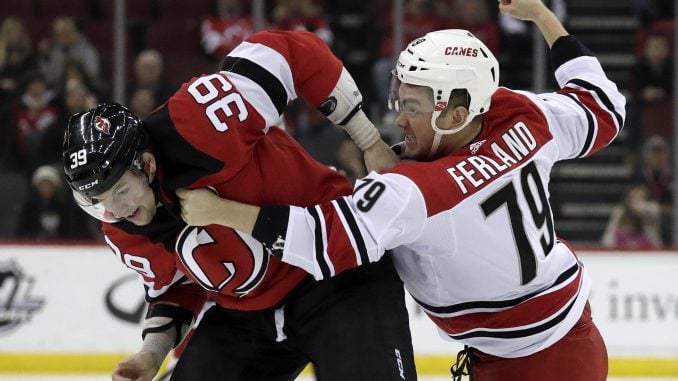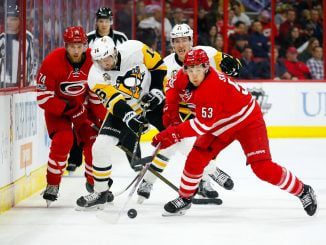
RALEIGH — The Hurricanes wrapped up their season-long five-game road trip with a 4-1 record, keeping pace in the Eastern Conference playoff race. Carolina now has three straight at home with a chance to keep the momentum going in the right direction.
Category 1: Micheal Ferland had his fourth fight of the season in Carolina’s 3-2 loss on Sunday, the most for a Hurricanes player since Brad Malone racked up nine fighting majors in 2015-16.
It illustrates part of the reason the team targeted Ferland last offseason — as protection against other teams taking advantage of Carolina’s smaller skill players.
Has it worked?
Overall, the Hurricanes have been pleased with Ferland’s output (15 goals, 16 assists in 48 games), even if his production has slowed considerably since the first two months of the season (just four goals in the past 27 games, including none on the power play).
The good news is even if Ferland isn’t producing goals, he’s an underrated passer and — to get to the crux of this point — a factor beyond the scoreboard.
Ferland’s fights haven’t translated to wins — Carolina is 1-3 when he drops the gloves, the lone victory coming when he pummeled Nashville’s Austin Watson in the first period of an eventual 6-3 win. But even on the nights he doesn’t fight, he serves as a bit of a nuclear deterrent — there really isn’t a heavyweight division of fighters in the NHL anymore, but Ferland is definitely one of a handful of players that can stand up to anyone in the league if needed.
The flip side is that the fights have seemingly taken their toll on Ferland. Even if a concussion earlier this season and a lingering back problem weren’t caused directly by fights, the scraps certainly contribute to the wear and tear that has limited Ferland in more than 10 games this season.
Fighting is a crowd-pleaser, for sure, and it has its place in certain situations. The question the Hurricanes face as the trade deadline approaches is: Does Ferland’s presence warrant keeping him at the risk of losing him for nothing in this summer free agency?
Carolina is 4-4-3 in games Ferland has either missed completely or left early (two due to injuries, once when sick). That includes missing Carolina’s 6-5 loss to Washington on Dec. 14. In that game, Capitals superpest Tom Wilson had a goal and an interference penalty in 15:37 of ice time. When Wilson and the Caps hosted Carolina nearly two weeks later in D.C. — with Ferland back in the lineup — he had no points in 13:58 in Washington’s 3-1 win.
Both were Carolina losses, but did Ferland’s presence in Game 2 have an impact on Wilson’s effectiveness? In the second game, with Ferland playing, Wilson registered four hits. The first? Wilson did not register a hit.
Do hits or goals for just two games really show any correlation to how one player impacts another in such a small sample size? Surely not. But we won’t get a third meeting between the two — set for March 28 — if Ferland is gone at the deadline.
Category 2: Plus/minus is a flawed statistic, to be sure, but it can be a great indicator of how a team is playing overall — you know, since more goals for and less against usually equals more wins.
Take Jaccob Slavin, for example. After 37 games this season, Slavin was a staggering minus-18. For a player who was plus-25 in his career despite playing for a team that was not in the playoffs in any of his first three seasons, that was surprising, to say the least. I don’t think any close observer of the team felt Slavin was playing below his abilities or struggling defensively in that stretch.
In the 20 games since — starting Dec. 31 — Slavin is plus-13, and Carolina is 14-5-1. Such is life with a fickle statistic like plus/minus.
Here’s more: Through 17 games, Brett Pesce was plus-5 — fueled by a plus-7 in the first five games of the season. Pesce then returned from injury on Dec. 5 and was minus-1 in the next 11, bringing his rating to plus-4.
That again takes us to Dec. 31, and Pesce was plus-3 in that win over Philadelphia and plus-11 since — giving him a plus-18 on the season. A quick look at all of Carolina’s D shows a similar pattern.
Yes, you can find some truth in plus-minus, but the biggest truth is whether or not the team is winning.
Category 3: Teuvo Teravainen and Sebastian Aho each have four shorthanded points this season, two shy of the Hurricanes record of six by Justin Williams back in the Stanley Cup season of 2005-06.
Williams played 291:20 shorthanded minutes that year, the second most by a forward in a season since the franchise’s relocation. Current coach Rod Brind’Amour had a staggering 339:38 that year (with five shorthanded points) to hold the mark.
By comparison, Teravainen and Aho have played a sliver of that amount — Aho checks in at 59:17, while Teravainen has played just 41:02 shorthanded.
No one in team history has scored shorthanded at the pace of Carolina’s two young Finns. As it stands now, Aho (with three goals and an assist with six shots) is getting a point every 14:49 of shorthanded ice time, while Teravainen (with, unsurprisingly, one goal and three assists with seven shots) is getting a point every 10:15.
The only players in that realm in Hurricanes history are Eric Staal (four points in 69:23 in 2013-14) and Elias Lindholm (five points in 88:59 in 2016-17).
Carolina has seemingly had a wealth of shorthanded chances in recent years, often by Jordan Staal and Joakim Nordstrom.
Staal had 12 shorthanded shots in 2013-14, and 15 more in 2016-17 — but of those 27 shots, only two went in the net, and he has just four shorthanded goals in 441 games with the Hurricanes.
Joakim Nordstrom, often paired with Staal shorthanded during his three-year stint with Carolina, had two 10-shots seasons but totaled just one goal, and had one shortie in three shots during his first year in Carolina in 2015-16.
Jordan Martinook has already registered 10 shorthanded shots this season, and Brock McGinn has nine — each has one goal and no assists to show for it. Warren Foegele has eight shots and no points.
A look around the league shows that these players are not alone — many of the league’s best shorthanded shot creators can’t get the puck in the net. Florida’s Colton Sceviour is credited with 19 shots on the penalty kill this year and no goals. Colorado’s Matt Calvert has 17 shots and no goals.
Even Vegas’ William Karlsson — he of the inflated 23.4 shooting percentage last season — has potted just one of his 12 shorthanded shots this year.
If the Hurricanes get Staal back from injury, his faceoff acumen would be welcome, particularly on the PK. But that doesn’t mean Brind’Amour should cut back on the opportunities Aho and Teravainen get to kill penalties — especially when they’ve only allowed seven and five goals against, respectively, when doing so, but mostly because they create offense with results.
Category 4: Speaking of Staal, he was back on the ice for Thursday’s practice at PNC Arena, the Hurricanes’ first at home since returning from their five-game road trip. In a yellow no-contact jersey and all smiles, Staal didn’t seem at all limited by the aftereffects of the concussion that has had him out of the lineup since he exited Carolina’s 3-0 loss to Pittsburgh on Dec. 22.
Brind’Amour was still unsure of Staal’s return to the lineup, but the 30-year-old center did take some drills centering Ferland and Teravainen. That moved Martinook out of the middle and back onto Lucas Wallmark’s wing along with Andrei Svechnikov, while McGinn skated in a fourth-line rotation that included Saku Maenalanen and Foegele playing with center Greg McKegg.
Staal was relieved to be back on the ice.
“Obviously, the last few weeks I’ve been feeling a lot better, just having the energy throughout the day and stuff, and I’ve just been building off of that,” he said. “As of late, I’ve been able to push with no setbacks and push enough to get out there with the guys, which has been nice.”
Staal said it is a hard injury to cope with because there are no timelines like most sports injuries, but he said it taught him a lot about concussions and his body.
“You don’t really understand it until you go through it, for the most part,” he said. “It’s unfortunate that I had to go through it, but I learned a lot.”
Brind’Amour was still reluctant to give a timetable for Staal’s return to the lineup, but he’s obviously pleased with the prospects of getting his big pivot back.
“We’ve missed him, and we’ve managed to kind of hang around,” Brind’Amour said. “And hopefully we’ll get him back soon.”
Category 5: The Hurricanes face Edmonton and Dallas in a back-to-back tonight and Saturday. It will be a big weekend of games for Carolina, especially with both the Blue Jackets and Canadiens — two teams the Hurricanes are chasing for a playoff berth — losing Thursday night.
The Oilers have lost two straight and won just once in their last nine games. The Stars — in the first wild-card spot in the Western Conference despite having only 63 points — will be playing the final game of a five-game road trip that saw them win just once in the first four games and get annihilated 6-0 Thursday in Tampa Bay.
Edmonton’s Connor McDavid has scored just once in five career games against the Hurricanes, and Carolina has held him to a reasonable one point per game. Limiting the Oilers captain will again be key, but the Hurricanes must also keep Leon Draisaitl — seven combined points in his last two games against Carolina — in check.
Edmonton coach Ken Hitchcock said Thursday that Mikko Koskinen will start in net, and his lone appearance against the Hurricanes was in relief for Cam Talbot last month. The Hurricanes chased Talbot with three goals in the first 11:02 on Jan. 20 in Edmonton, but Koskinen was given the loss after allowing three of his own in a 7-4 Carolina win (Lucas Wallmark added an empty-net goal).
The Hurricanes have been unkind to Finnish goalies this year. On top of Koskinen’s three goals allowed in less than 50 minutes, here’s how other Finnish netminders have fared against Carolina this year:
Pekka Rinne, Nashville: 0-1-1, 5 GA in 29:30
Tuukka Rask, Boston: 0-1-1, 5 GA in 57:20
Juuse Saros, Nashville: 0-0-0, 0 GA in 29:24
Joonas Korpisalo, Columbus: 0-0-0, 0 GA in 30:26
Antti Raanta, Arizona: 1-0-0, 3 GA in 61:17
Raanta was the only one with a standout performance, earning an overtime win with a 48-save effort. Both Korpisalo and Saros (replacing Rinne) came on in relief, like Koskinen, with games already in Carolina’s control, and Rask was victimized by countrymen Aho and Teravainen for a combined three goals.




